B2.8 Multiply and divide fractions by fractions, using tools in various contexts.
Skill: Multiplying and Dividing Fractions by Other Fractions, Using Tools, in a Variety of Contexts
Multiplication
When multiplying fractions, there is a recommended progression to follow. In the junior grades, students began to formally work with multiplying fractions. In Grade 4, students represented the relationship between the repeated addition of a unit fraction and the multiplication of that unit fraction by a whole number. In Grade 5, they multiplied and divided one-digit whole numbers by unit fractions, and in Grade 6 they multiplied and divided whole numbers by proper fractions.
Example
How many cards will the student who is to distribute half a card to 4 classmates need?
By understanding the situation, students recognize that there is a multiplication of a quantity, either \(4\; \times \;\frac{1}{2}\), which can be represented by repeated addition, or \(\frac{1}{2}\; + \;\frac{1}{2}\; + \;\frac{1}{2}\; + \;\frac{1}{2}\). To find the answer, the students represent the situation in a mental or semi-concrete way or use their knowledge of the addition of the fractions in question. Some students can visualize that 2 equal parts of a 1st card are distributed to 2 comrades and that 2 equal parts of a 2nd card are distributed to the 2 other comrades. They therefore need 2 boxes.
Others may think of the following abstract representation: "I need 4 times a half-carton. I know that \(4 \times \;\frac{1}{2}\) is equal to 2, because 2 halves make 1. Therefore, I need 2 boxes." Others may illustrate the problem as follows, then mentally combine the pieces 2 by 2 to see that there are the equivalent of 2 full boxes.

Source: translated from Guide d'enseignement efficace des mathématiques de la 4e à la 6e année, Numération et sens du nombre, Fascicule 2, Fractions, p. 86-87.
However, it is more difficult to make sense of multiplying a whole number by a fraction (for example, \(\frac{1}{2} \times \;3\)). These situations are explored starting in grade 5 by multiplying a whole number by a unit fraction.
Example
In a Grade 6 classroom, students are wearing toques.
If there are 24 students in the classroom, how many students are wearing toques?
- Multiplication using a double number line
To find \(\frac{1}{2}\) of 24, I divide 24 by 2, which gives me 12.
I represent the 24 students below the line and half of 24 on the top of the line.

There are 12 students wearing toques.
- Multiplication performed using the area model
I decompose 24 into \(20\; + \;4\). I determine half of 20 and half of 4, \(10\; + \;2\; = \;12\).
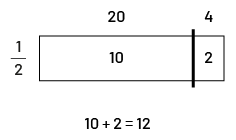
There are 12 students wearing toques.
In grade 6 , as they examine the concept of multiplying a whole number by a proper fraction, they will learn that the fraction of a set \(\frac{2}{3}\) of 6 is related to multiplication and that this situation can be represented by multiplication \(\frac{2}{3}\; \times \;6\). However, there is a danger in introducing this multiplication in grade 6 , as there is a danger of forcing obedience to rules and rote learning without conceptual understanding. It takes a good degree of abstraction to accept a situation like \(\frac{1}{2}\) of 12 as multiplication.
Example
In a rectangular field with an area of 100 m2, Mr. Siby has planted cucumbers on \(\frac{2}{5}\)of the field . What area of the field, in m2, is devoted to cucumbers?
Source: translated from Les mathématiques…un peu, beaucoup, à la folie!, Guide pédagogique, Numération et Sens du nombre/Mesure, 6e, Module 2, Série 2, p. 309.
- Multiplication performed using the area model
I have decomposed 100 into \(25\; + \;25\; + \;25\; + \;25\). I also decomposed \(\frac{2}{5}\) into \(\frac{1}{5}\; + \;\frac{1}{5}\). I know that \(\frac{1}{5}\) of 25 is 5 since \(5\; \times \;5\; = \;25\).
I added up the partial products to arrive at 40.
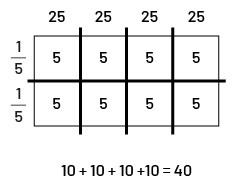
The area of the field dedicated to the cultivation of cucumbers is 40m2.
- Multiplication using a personal algorithm
I decomposed \(\frac{2}{5}\) into \(2\; \times \;\frac{1}{5}\).
Using the associative property, I multiplied \(\frac{1}{5} \times \;2\; \times \;100\).
I multiplied \(\frac{1}{5}\; \times \;200\).
Multiplying by \(\frac{1}{5}\) is the same as dividing by 5.
I get 40.
\[\begin{array}{l}\frac{2}{5}\; \times\;100\; = \;2\; \times\;\frac{1}{5}\; \times\;100\; = \;\frac{1}{5}\; \times\;2\; \times \;100\\\quad \quad \quad \quad \quad \quad \quad \quad \,\; = \;\frac{1}{5}\; \times 200\\\quad \quad \quad \quad \quad \quad \quad \quad \,\; = \;200\; \div \;5\\\quad \quad \quad \quad \quad \quad \quad \quad \,\; = \;40\end{array}\]
The area of the field dedicated to the cultivation of cucumbers is 40 m2.
Multiplying a Fraction by a Fraction
In Grade 7, students multiply and divide fractions by other fractions.
Manipulatives and visuals representing fractions can help to show the action that results when multiplying and dividing facts. It is from these visual representations that students construct conceptual understanding of multiplying and dividing with fractions.
Source: inspired by and translated from Les mathématiques… un peu, beaucoup, à la folie, Guide pédagogique, Numération et Sens du nombre/Mesure, 8e, Module 1, Série 2, p. 143-144.
Multiplication Without Partitioning
- Multiplication performed with an area model
The student can use the area model, either with a rectangle or a square to multiply a fraction by another fraction.
Example
\(\frac{1}{4}\; \times \;\frac{2}{3}\;{\rm{or}}\;\frac{1}{4}\;{\rm{of}}\;\frac{2}{3}\)
Since I am looking for \(\frac{1}{4}\) of \(\frac{2}{3}\), I vertically divide a rectangle into 3 equal parts and colour 2 parts, which corresponds to \( \frac{2}{3}\) of the rectangle.
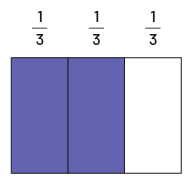
Then I horizontally divide the same rectangle into 4 equal parts and colour 1 part, which is \(\frac{1}{4}\) of the rectangle.
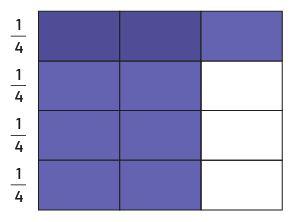
The fraction that represents \(\frac{1}{4}\) corresponds to the number of parts coloured twice, that is \(\frac{2}{{12}}\). The numerator corresponds to the darker coloured parts and the denominator corresponds to the number of parts of the same size in the whole, that is 12 parts.
The fraction \(\frac{2}{{12}}\) can be simplified to an equivalent fraction of \(\frac{1}{6}\) by dividing the numerator and denominator by 2.
- Multiplication performed with a symbolic representation
The student multiplies the numerators together and the denominators together.
\(\frac{1}{4}\; \times \;\frac{2}{3}\; = \;\frac{{1\; \times \;2}}{{4\; \times \;3}}\;= \frac{2}{12}\)
Source: inspired by and translated from Les mathématiques… un peu, beaucoup, à la folie!, Guide pédagogique, Numération et Sens du nombre/Mesure, 8e, Module 1, Série 2, p. 253-254.
- Multiplication Performed by Finding the LCM
The lowest common multiple (LCM) of 4 and 3 is 12.
I divide a rectangle into 12 equal parts (3 units by 4 units based on the denominators) and represent \(\frac{2}{3}\)of the rectangle.
Then I find \(\frac{1}{4}\) of the 8 parts or \(\frac{1}{4}\) of two columns = 2 parts.
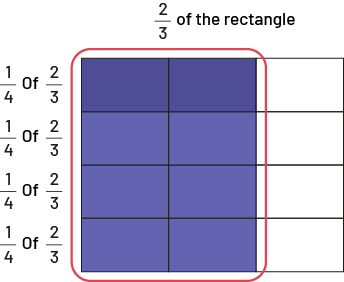
Then, \(\frac{1}{4}\)of \(\frac{2}{3}\)of the rectangle is equal to 2 parts of the set of 12.
\(\frac{1}{4}\;{\rm{of}}\;\frac{2}{3}\;\text{of}\;\;\text{rectangle}\;\;{\rm{ = }}\; \frac{2}{{12}}\;\;{\rm{or}}\;\frac{1}{6}\)
Multiplication With Partitioning
- Multiplication performed with an area model
\(\frac{3}{4}\; \times \;\frac{2}{3}\;{\rm{or}}\;\frac{3}{4}\;\;{\rm{of}}\;\;\frac{2}{3}\)
Since I am looking for \(\frac{3}{4}\) of \(\frac{2}{3}\), I vertically divide a rectangle into 3 equal parts and colour 2 parts, which corresponds to \( \frac{2}{3}\) of the rectangle.

In the same way, I can decompose \(\frac{3}{4}\) into \(\frac{1}{4}\; + \;\frac{1}{4} + \;\frac{1}{ 4}\).
I divide the same rectangle horizontally into 4 equal parts and first colour 1 part, which corresponds to \(\frac{1}{4}\) of the rectangle, that is 3 squares among 12. The fraction that represents \(\frac{1}{4}\) of \(\frac{2}{3}\) corresponds to the number of parts coloured twice, that is \(\frac{2}{{12}}\). The numerator corresponds to the darker coloured parts and the denominator corresponds to the number of parts of the same size in the whole, that is 12 parts (figure 1).

I'm looking for \(\frac{3}{4}\), so I can think of this as \(2\; + \;2\; + \;2\) since \(\frac{1}{4}\) represents 2 parts (Figure 1). So, \(\frac{3}{4}\) represents 6 parts or \(\frac{6}{{12}}\) (Figure 2). If I move 2 of the squares, I can see that \(\frac{6}{{12}}\) is also \(\frac{1}{2}\) (Figure 3).
Division
When dividing fractions, there is a certain progression to follow. The exploration of division, like that of other operations, should focus on concrete and semi-concrete representations and not on algorithms. Students can then reactivate their prior knowledge and grasp the meaning of the operation. In order to understand division, it is essential to examine the meaning of the division and the nature of the numbers that make up the division. Division has the meaning of sharing when we look for the size of the groups; it has the meaning of grouping when we look for the number of groups.
Thus, in grade 5 , dividing a whole number by a unit fraction (for example, \(2\; \div \;\frac{1}{3}\)) is well represented using grouping. In this case, the fraction is the divisor.
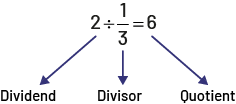
For example, if we have 2 licorices and we want to give each child \(\frac{1}{3}\) licorice, we proceed to a division since we have to separate a quantity (2 licorices ) in equal amounts of (\(\frac{1}{3}\) of licorice) to determine how many equal amounts or groups can be created (6 children will receive \(\frac{1}{3}\) of licorice each). In this case, it is important to recognize that the quotient expresses a number of sections, or thirds, and not a quantity of objects (liquorice).
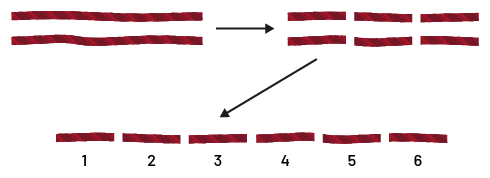
Source: translated from Guide d'enseignement efficace des mathématiques de la 4e à la 6e année, Numération et sens du nombre, Fascicule 2, Fractions, p. 80-82.
In the case of a division of a whole number by a fraction, division usually takes on the meaning of grouping. Thus, the analogy of repeated subtraction is appropriate since it involves separating parts.
For example, in dividing 2 by \(\frac{1}{4}\) (\(2\; \div \;\frac{1}{4}\)), doing \(2\; - \;\frac{1}{4}\; - \;\frac{1}{4}\; - \;\frac{1}{4}\; - \;\frac{1}{4} \; - \;\frac{1}{4}\; - \;\frac{1}{4}\; - \;\frac{1}{4}\; - \;\frac{1}{ 4}\), we can create 8 groups of \(\frac{1}{4}\). However, the group created is rather abstract since it is a group that is a fraction of a whole. The questions "How many \(\frac{1}{4}\) can be created with 2 wholes?" and "How many times does \(\frac{1}{4}\) go into 2?" can help visualize the operation.
In Grade 6, students divide a whole number by a proper fraction.
Example
\(6\; \div \;\frac{3}{5}\; = \;10\)
Area Model
In order to create a tessellation, each team needs the equivalent of \(\frac{3}{5}\;\)squares on a sheet. How many teams can complete the task if we have 6 sheets?

Linear Model
A teacher has a 6-metre rope and wants to cut it into sections of one metre each. How many sections can she create?

Source: translated from Guide d'enseignement efficace des mathématiques de la 4e à la 6e année, Numération et sens du nombre, Fascicule 2, Fractions, p. 100-102.
In Grade 7, students will divide fractions by other fractions.
Division of a Fraction by a Fraction
Division Without Partitioning
Example
\(\frac{5}{6}\; \div \;\frac{1}{6}\)
- Division performed with an area model
I represent \(\frac{5}{6}\) of a rectangle by dividing the rectangle into 6 equal parts of which 5 parts are shaded. I ask myself the question "How many \(\frac{1}{6}\) are there in \(\frac{5}{6}\)?" »

There are 5 one-sixths in \(\frac{5}{6}\). So, \(\frac{5}{6}\; \div \;\frac{1}{6}\; = \;5\).
- Division performed with a symbolic representation
Since the dividend and divisor have a common denominator, I can divide the numerators and divide the denominators.
\(\frac{5}{6}\; \div \;\frac{1}{6}\; = \frac{{5\; \div \;1}}{{6\; \div \; 6}}\;=\frac{5}{1}\;=5\)
Division With Partitioning
Example
\(\frac{3}{4}\; \div \;\frac{1}{2}\)
- Division performed using a number line
I represent \(\frac{3}{4}\)on the number line (red line). I ask myself the question "How many groups of \(\frac{1}{2}\) are there in \(\frac{3}{4}\)?" »
Knowing that \(\frac{2}{4}\; = \;\frac{1}{2}\), I determine how many \(\frac{2}{4}\) there are in \(\frac{3}{4}\).

On the number line above, I can see that there is one one half at the \(\frac{2}{4}\) mark and from \(\frac {2}{4}\)to \(\frac{3}{4}\), there is one half of another half. So in total there are one and a half halves.
- Division Using a Common Denominator
\(\begin{array}{l}\frac{3}{4}\; \div \;\frac{1}{2}\; = \;\frac{3}{4}\; \div \;\frac{2}{4}\\\quad \quad \;\; = \;\frac{{3\; \div \;2}}{{4\; \div \;4}}\\ \quad \quad \;\; = \;\frac{{\frac{3}{2}}}{1}\; = \;\frac{3}{2}\\\quad \quad \;\;= \;1\frac{1}{2}\end{array}\)
Knowledge: Fractions
The word fraction comes from the Latin fractio which means "break". In order to determine a fraction of a whole that has been broken or divided into parts, the parts must be of equal sizes.
Source: translated from Guide d'enseignement efficace des mathématiques de la 4e à la 6e année, Numération et sens du nombre, Fascicule 2, Fractions, p. 33.
Knowledge: Fractional Notation
The fractional notation \(\frac{a}{b}\) is usually associated with the concept of part of a whole. The whole can be an element or a set of elements.
Example
- I gave 1 fourth (\(\frac{1}{4}\)) of my sandwich to Alex.

- A fourth (\(\frac{1}{4}\)) of my marbles are blue.

However, fractional notation can also be associated with other concepts such as division, ratio and operator.
Source: translated from Guide d'enseignement efficace des mathématiques de la 4e à la 6e année, Numération et sens du nombre, Fascicule 2, Fractions, p. 36.
